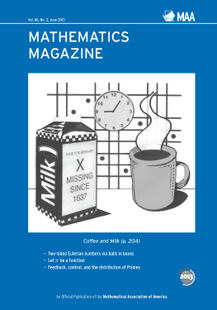- About MAA
- Membership
- MAA Publications
- Periodicals
- Blogs
- MAA Book Series
- MAA Press (an imprint of the AMS)
- MAA Notes
- MAA Reviews
- Mathematical Communication
- Information for Libraries
- Author Resources
- Advertise with MAA
- Meetings
- Competitions
- Programs
- Communities
- MAA Sections
- SIGMAA
- MAA Connect
- Students
- MAA Awards
- Awards Booklets
- Writing Awards
- Teaching Awards
- Service Awards
- Research Awards
- Lecture Awards
- Putnam Competition Individual and Team Winners
- D. E. Shaw Group AMC 8 Awards & Certificates
- Maryam Mirzakhani AMC 10 A Awards & Certificates
- Two Sigma AMC 10 B Awards & Certificates
- Jane Street AMC 12 A Awards & Certificates
- Akamai AMC 12 B Awards & Certificates
- High School Teachers
- News
You are here
Mathematics Magazine Contents—June 2013

In applications, as in theory, we like to reduce our assumptions to the most essential. Two nice examples are in this issue. We see how the Prime Number Theorem can be predicted from some basic observations about the Sieve of Eratosthenes. Then, we see how a practical rule for cooling coffee—often derived from Newton's Cooling Law—actually needs only a simple convexity requirement. There's much more. Enjoy! —Walter Stromquist
Vol. 86, No. 3, pp.158-236.
Journal subscribers and MAA members: Please login into the member portal by clicking on 'Login' in the upper right corner.
ARTICLES
Two-Sided Eulerian Numbers via Balls in Boxes
T. Kyle Petersen
The Eulerian numbers count permutations according to the number of descents. The two-sided Eulerian numbers count permutations according to number of descents and the number of descents in the inverse permutation. Here we derive some results for Eulerian and two-sided Eulerian numbers using an elementary "balls-in-boxes" approach. We also discuss an open conjecture of Ira Gessel about the two-sided Eulerian numbers.
To purchase the article from JSTOR: http://dx.doi.org/10.4169/math.mag.86.3.159
Let $$\pi$$ Be a Function
Justin T. Schultz and Catherine Stenson
In the plane, the ratio of the circumference of a circle to its diameter is always $$\pi$$. On a sphere, however, this ratio (which we denote $$\Pi$$) takes on other values, provided the diameter is measured along a great circle on the sphere. In this article, we explore $$\Pi$$ as a function of radius on surfaces of revolution. We also consider the inverse problem—we begin with a function and, under certain conditions, find a surface or Riemannian manifold with $$\Pi$$ equal to that function.
To purchase the article from JSTOR: http://dx.doi.org/10.4169/math.mag.86.3.177
Feedback, Control, and the Distribution of Prime Numbers
Susan H. Marshall and Donald R. Smith
A differential-difference equation modeling the density of primes has been independently discovered several times by applied mathematicians with an interest in number theory, including Lord Cherwell. In this article, we use the framework of feedback and control to explain the natural connection between this equation and the distribution of prime numbers. Building on work of E. M. Wright, who learned of the equation from Cherwell and studied it for over a decade, we explain how the model predicts both the prime number theorem and a theorem of Littlewood. We close with known limitations of the model.
To purchase the article from JSTOR: http://dx.doi.org/10.4169/math.mag.86.3.189
NOTES
Cooling Coffee without Solving Differential Equations
Robert Israel, Peter Saltzman, and Stan Wagon
A classic textbook problem is to show, assuming Newton's law of cooling, that if cold milk is added to coffee that has been cooling down, the result will be colder than if the milk was added at an earlier time. We formulate and prove a theorem that shows this holds when the linear function of Newton's law is replaced by any function satisfying a certain weak convexity condition. This is relevant to the real-world problem, since Newton's law is not an adequate model for cooling liquids; it ignores the large amount of heat loss due to evaporation, as well as the smaller loss due to radiation.
To purchase the article from JSTOR: http://dx.doi.org/10.4169/math.mag.86.3.204
Intrinsically Defined Curves and Special Functions
Antonín Slavík
We study two classes of plane curves with prescribed curvature. First, we investigate spirals whose curvature is a power function, and express coordinates of the spirals' centers in terms of the gamma function. For curves in the second family, the curvature is a multiple of the sine function. We show that this family contains infinitely many closed curves and provide their characterization in terms of the zeroth-order Bessel function.
To purchase the article from JSTOR: http://dx.doi.org/10.4169/math.mag.86.3.211
The Integrating Factors of an Exact Differential Equation
Mowaffaq Hajja
This note investigates the integrating factors $$\mu$$ of an exact differential equation $$M dx + N dy = 0$$ and finds conditions on the potential $$F$$ under which $$\mu$$ is a function of $$F$$.
To purchase the article from JSTOR: http://dx.doi.org/10.4169/math.mag.86.3.220
PROBLEMS
Proposals 1921-1925
Quickies 1031 & 1032
Solutions 1896-1900
To purchase the article from JSTOR: http://dx.doi.org/10.4169/math.mag.86.3.227
REVIEWS
Weather, disasters, and the Babylonian ISO
To purchase the article from JSTOR: http://dx.doi.org/10.4169/math.mag.86.3.235




